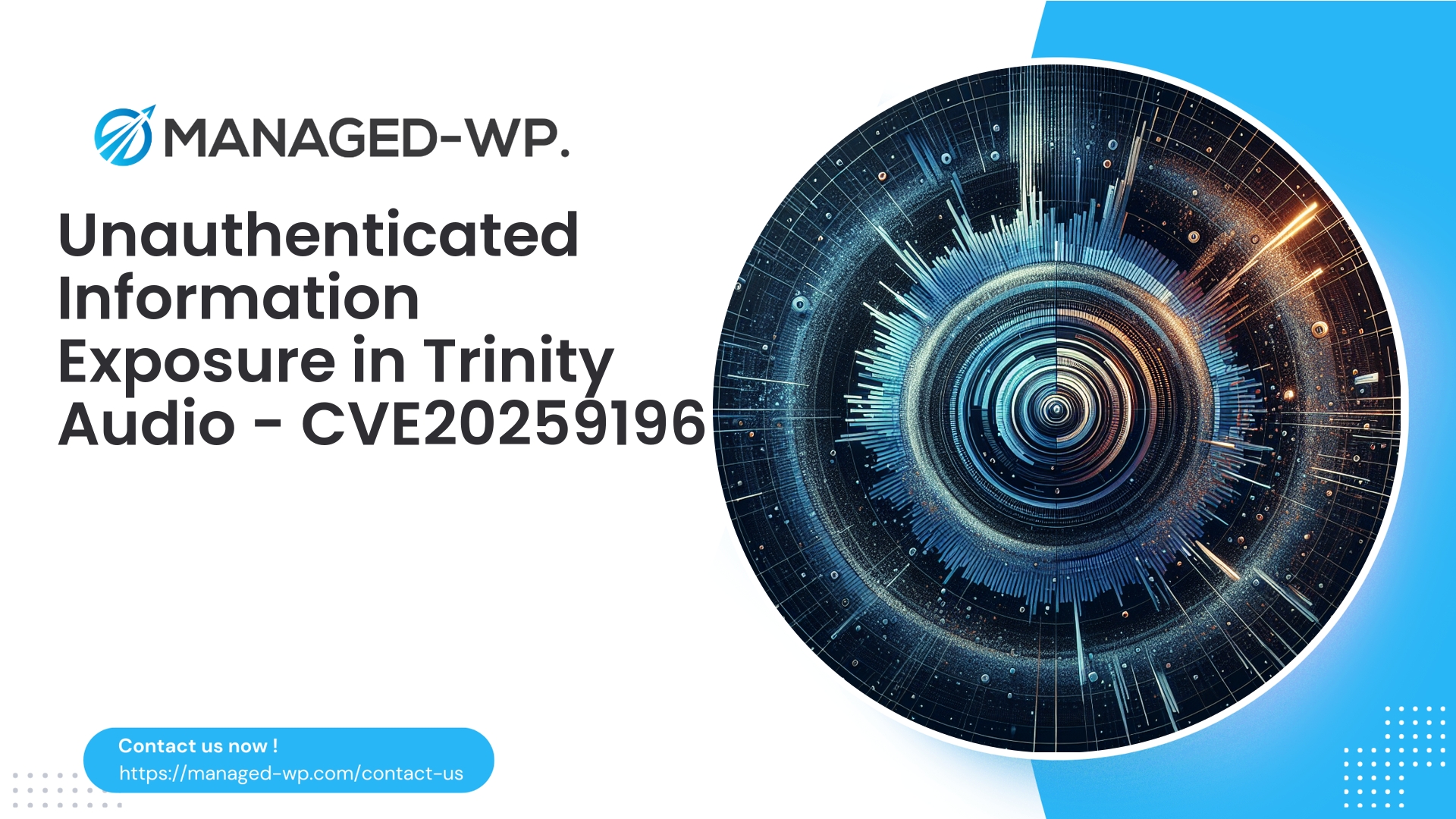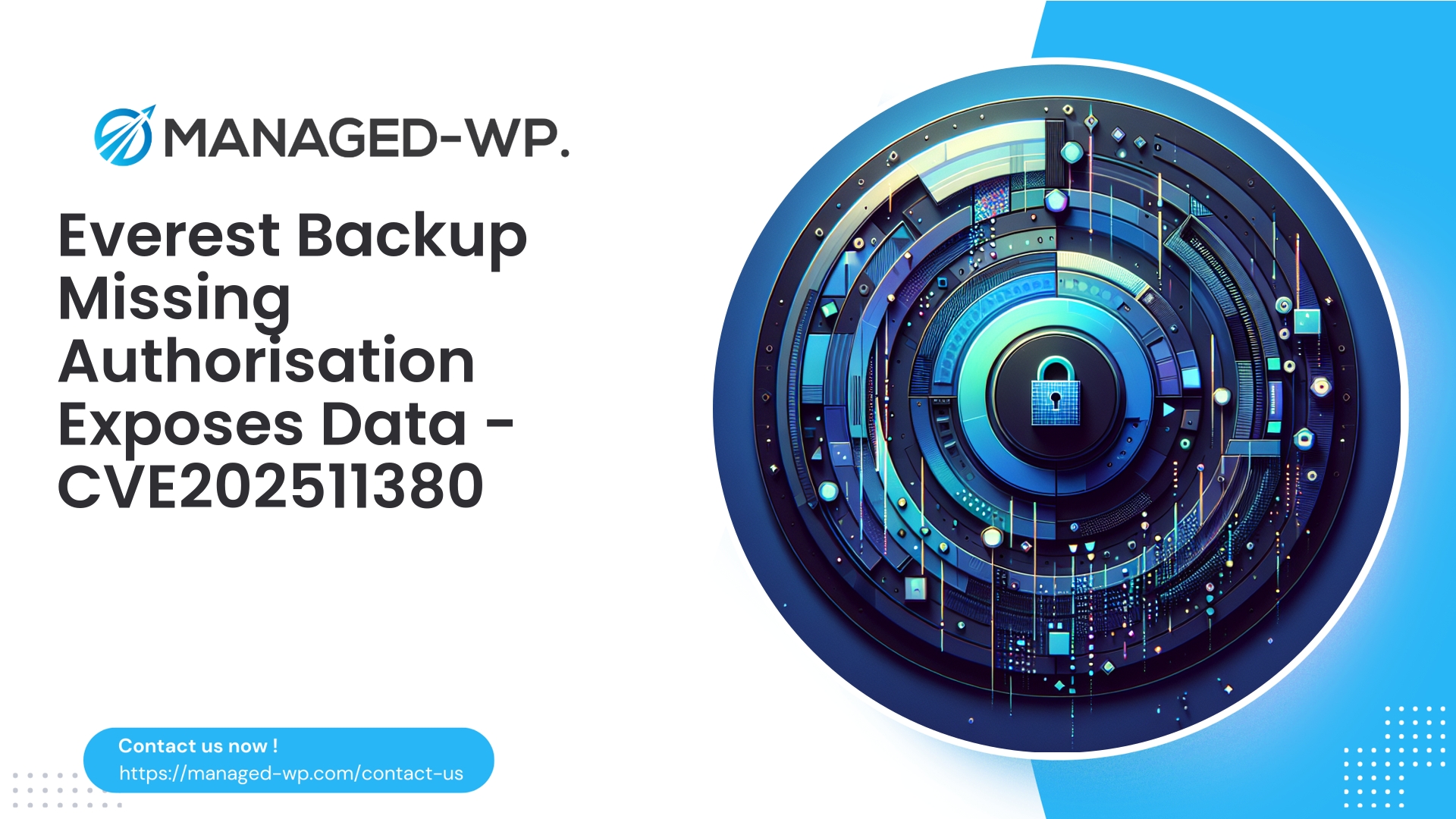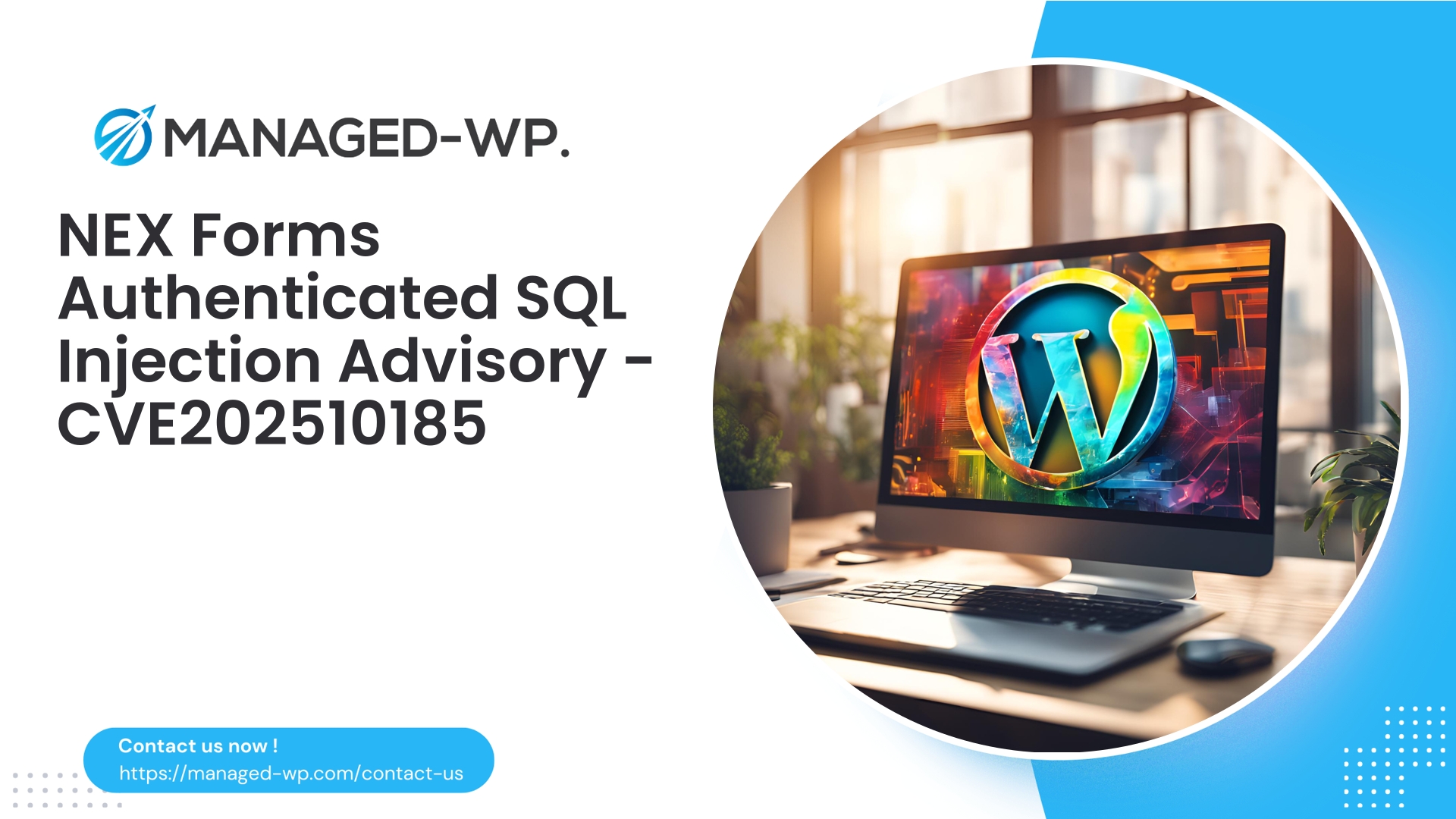| 插件名稱 | Trinity Audio |
|---|---|
| 漏洞類型 | 未經認證的資訊洩露 |
| CVE編號 | CVE-2025-9196 |
| 緊急 | 低的 |
| CVE 發布日期 | 2025-10-10 |
| 來源網址 | CVE-2025-9196 |
Trinity Audio <= 5.21.0 — 未經身份驗證的敏感資料外洩 (CVE-2025-9196)
2025 年 10 月 10 日,Trinity Audio WordPress 外掛程式(版本 5.21.0 及更早版本)被揭露有一個嚴重的安全問題。該漏洞編號為 CVE-2025-9196,涉及未經身份驗證的敏感資料外洩-這意味著威脅行為者無需任何身份驗證即可存取機密資訊。
身為總部位於美國的 Managed-WP 安全專家,我們經常分析 WordPress 生態系統中此類漏洞。這份全面的分析報告概述了漏洞的性質、潛在風險以及清晰可行的緩解策略。無論您是網站所有者、管理員還是開發人員,本指南都將為您提供立即保護網站的關鍵步驟。
重要的: 插件供應商發布了包含此修復的 Trinity Audio 5.22.0 版本。更新到此版本仍然是最佳的防禦措施。對於無法立即更新的網站,請遵循此處詳述的建議緩解措施,以在準備打補丁期間最大限度地減少風險。
簡要總結(TL;DR)
- 什麼: Trinity Audio 外掛程式版本 <= 5.21.0 中存在未經驗證的敏感資料外洩漏洞 (CVE-2025-9196)。
- 嚴重程度: 評級較低(CVSS 5.3),但有敏感資料外洩的風險,可透過連鎖攻擊加以利用。
- 立即採取行動: 請立即將插件更新至 5.22.0 版本。如果無法更新,請實施防火牆規則以阻止危險端點,輪換暴露的憑證,並對網站進行全面掃描。
- 預防: 保持外掛完全更新,使用具有虛擬修補功能的託管 WordPress 防火牆,強制執行最小權限原則,並定期進行金鑰輪換。
了解脆弱性(實踐角度)
「未經認證的資訊外洩」漏洞可讓未經授權的使用者取得 Trinity Audio 外掛程式無意中傳回的敏感資料。典型的洩漏資料可能包括:
- 插件設定中嵌入的 API 金鑰或身份驗證令牌
- 私有或內部配置數據,
- 使用者識別碼或系統特定ID,
- 可能洩漏內部系統細節,從而為後續攻擊提供便利的元資料。
雖然此漏洞可能不會直接導致網站完全被接管,但暴露的金鑰和識別碼會對後續攻擊(例如網路釣魚、憑證填充或惡意 API 互動)帶來重大風險。
Trinity Audio 5.22.0 版本已修復此漏洞。請盡可能優先更新;如果無法更新,以下章節提供了緩解和偵測的即時步驟。
潛在的利用場景
了解攻擊者可能採取的策略對於更好地確定事件回應的優先順序至關重要:
-
API金鑰洩漏
- 攻擊者取得音訊服務 API 金鑰,然後濫用這些金鑰來存取或操縱音訊內容,可能會注入惡意程式碼或內容。
-
用戶標識符收集
- 收集到的使用者電子郵件和 ID 可能被用於有針對性的社會工程攻擊或暴力破解攻擊。
-
進一步偵察
- 暴露的元資料可能會洩露內部服務端點或版本信息,從而使更廣泛的攻擊成為可能。
-
自動化大規模探測
- 自動掃描器以許多 WordPress 網站為目標,大規模收集暴露的秘密訊息,以便轉售或重複使用。
由於這種未經身份驗證的漏洞門檻極低,自動化機器人會在漏洞揭露後不久便積極掃描並利用該漏洞網站。請將所有受影響的網站列為最高優先順序進行處理。
前24小時:立即採取補救措施
- 最好更新插件
- 立即將 Trinity Audio 升級至 5.22.0 或更高版本;驗證修復程式部署。
- 如果更新延遲,請採取以下緩解措施:
- 如果可行,請暫時停用該外掛程式。
- 強制執行 WAF/防火牆規則,阻止對易受攻擊的插件端點的請求。
- 限制對插件檔案及相關 REST/AJAX 端點的公開存取。
- 阻止可疑用戶代理並限制大批量自動請求。
- 對與插件端點的交互實施速率限制。
- 輪換暴露的憑據
- 立即變更外掛程式可能使用的 API 金鑰、令牌和 webhook 金鑰。
- 審查日誌
- 搜尋網頁伺服器、防火牆和插件日誌,尋找與洩漏時間範圍相關的異常指標。
- 掃描是否有洩漏跡象
- 對惡意軟體和完整性進行全面掃描,以發現未經授權的變更或可疑的有效載荷。
- 內部溝通
- 通知相關使用者和貢獻者有關臨時使用限制和正在進行的補救措施。
偵測漏洞利用(入侵指標)
請密切注意網站日誌和流量中的以下警告信號:
- 針對意外的 GET 或 POST 請求
/wp-content/plugins/trinity-audio/ - 可疑的 REST 或 admin-ajax.php 調用,其中包含“trinity”、“audio”或相關操作參數
- 來自異常 IP 位址或不常見地理位置的重複請求
- 使用異常或已知惡意使用者代理程式的請求通常是掃描程式的典型特徵。
- 包含的查詢參數
api_key=,token=或類似的憑證值 - 可疑的出站網路活動顯示存在資料竊取企圖
- 外掛目錄或上傳資料夾中的檔案發生意外更改
- 如果插件中啟用了資料匯出功能,則會出現異常活動。
在緩解措施實施過程中或實施之前發現的任何積極結果,都需要立即進行全面的法證調查。
WAF 和虛擬補丁規則範例,可立即提供保護
以下範例規則可新增至您的防火牆或伺服器設定中,以阻止攻擊嘗試。請根據您的環境調整這些規則,並在正式實施前進行全面測試:
- 阻止對插件 PHP 檔案的直接訪問
SecRule REQUEST_URI "@rx /wp-content/plugins/trinity-audio/.*\.php" \ "id:1001001,phase:1,deny,log,msg:'已封鎖直接存取 Trinity Audio 外掛程式 PHP 檔案'"location ~* /wp-content/plugins/trinity-audio/.*\.php$ { return 403; } - 阻止未經身份驗證的 REST 和 AJAX 插件端點訪問
SecRule REQUEST_URI "@contains admin-ajax.php" "chain,deny,log,id:1001002,msg:'阻止可疑的 admin-ajax AJAX 呼叫外掛程式'" SecRule ARGS_NAMES|ARGS "@rx trinity|audiota_" SecRule ARGS_NAMES|ARGS "@rx trinity|audiota_" - 阻止類似憑證竊取嘗試的查詢參數
SecRule REQUEST_URI|ARGS "@rx (api[_-]?key|token|secret|client[_-]?id)=\w{10,}" \ "id:1001003,phase:2,deny,log,msg:'可能存在憑證洩漏嘗試 - 阻止參數'" - 速率限制插件端點調用
limit_req_zone $binary_remote_addr zone=trinity_zone:10m rate=1r/s; location ~* /wp-content/plugins/trinity-audio/ { limit_req zone=trinity_zone burst=5 nodelay; - 阻止已知的惡意或掃描用戶代理
SecRule REQUEST_HEADERS:User-Agent "@rx (sqlmap|curl|python-requests|nikto|fuzzer)" \ "id:1001004,phase:1,deny,log,msg:'已封鎖已知的掃描 UA'" - 過濾敏感回應資料(虛擬修補)
範例 ModSecurity 過濾器,用於阻止回應中傳回的敏感令牌:
SecResponseBodyAccess On SecRule RESPONSE_BODY "@rx (API_KEY|client_secret|private_token)" \ "id:1001005,phase:4,deny,log,msg:'private_token)" \ "id:1001005,phase:4,deny,log,msg:'
筆記: 所有WAF規則應盡可能以監控模式啟動,以避免意外停機。重點阻止易受攻擊的插件端點,以確保網站功能完整。
如果現在無法更新:詳細的緩解措施
- 將網站置於維護模式,以最大限度減少風險。
- 停用 Trinity Audio 插件:
- 透過 WordPress 後台 -> 外掛程式 → 停用 Trinity Audio
- 或使用 WP-CLI:
wp plugin deactivate trinity-audio
- 如果繼續操作且外掛程式處於啟用狀態:
- 使用伺服器級規則阻止對插件目錄的直接檔案存取。
- 如果可用,請將外掛程式管理區域的受信任 IP 位址加入白名單。
- 加強 REST 和 AJAX 端點的安全性:
- 限制存取權限
wp-json和admin-ajax.php連接到受信任的網路或實作基於令牌的身份驗證中間件。
- 限制存取權限
- 輪換插件整合的任何外部 API 金鑰或金鑰。
- 持續監控所有訪問日誌和錯誤日誌,以發現可疑活動。
- 執行惡意軟體掃描程式並確認檔案完整性狀態。
- 盡快規劃並執行插件更新;在恢復正常運作之前,請先驗證修補程式後的插件功能。
事後調查清單
如果發現洩漏證據,請按以下步驟操作:
- 隔離受損系統:將網站從公共存取範圍中移除或置於嚴格的防火牆規則之後。
- 安全性日誌:備份所有伺服器、防火牆和應用程式日誌,以便進行取證分析。
- 範圍評估:識別受損文件、資料庫條目和憑證。
- 憑證輪換:更改 WordPress 管理員密碼、資料庫憑證和 API 金鑰。
- 如有可用且經過驗證的乾淨備份,請從中還原。
- 重新產生所有可能暴露的整合令牌或 Webhook。
- 掃描是否存在後門或註入程式碼,尤其是在上傳檔案和外掛目錄中。
- 進行根本原因分析,以確定攻擊途徑和影響。
- 通知受影響用戶並遵守法律/監管資料外洩通知要求。
如果您缺乏內部事件回應的專業知識,請立即與安全專業人員合作。
確認補救措施
套用更新或虛擬修補程式後,請透過以下方式驗證防禦系統的完整性:
- 測試之前存在漏洞的端點,以確保它們不再傳回敏感資料(使用 curl 或 Postman 等工具)。
- 日誌確認顯示沒有其他未經授權的資料外洩。
- 執行自動漏洞掃描以偵測殘留問題。
- 觀察 WAF 日誌中被阻止的漏洞嘗試(如果虛擬修補功能處於活動狀態)。
- 在正式環境重新啟用音訊功能之前,先在測試環境中檢查音訊功能。
- 針對已知的外掛端點執行 HTTPS 請求。
- 驗證回應時,請排除任何敏感標記或私有欄位。
- 執行自動現場掃描和人工檢查,以確認風險消除。
長期安全加固建議
- 制定並執行嚴格的、有據可查的更新策略,以便及時修復安全漏洞。
- 利用提供虛擬修補程式的託管式 WordPress WAF 服務,快速緩解威脅。
- 應用最小權限原則-避免在外掛程式中儲存高權限金鑰,使用作用域憑證。
- 保護外掛程式和 WordPress 設定資料-盡可能避免以明文形式儲存機密資訊。
- 實施持續的自動化掃描和日誌監控,以便快速偵測新的攻擊。
- 部署速率限制和機器人偵測系統,以減少自動化攻擊嘗試。
- 對使用的任何自訂或第三方外掛程式進行程式碼審查和安全審計。
- 定期維護異地備份並測試復原程序,以最大限度地減少事故造成的停機時間。
Managed-WP 如何增強您的 WordPress 安全態勢
Managed-WP 提供專為 WordPress 環境量身定制的企業級託管防火牆和安全服務。我們的方法包括:
- 漏洞揭露後立即進行快速漏洞驗證和虛擬修補程式開發,最大限度地縮短您的風險暴露期。
- 管理部署客製化的 WAF 規則,旨在以最小的誤報阻止漏洞利用模式。
- 全面的惡意軟體掃描,並結合可操作的清理協助或自動修復。
- 事故後分析和長期加固建議,並根據您獨特的站點架構進行調整。
如果沒有主動的虛擬修補程式和持續監控,在插件更新經過測試和部署之前,您的系統將始終處於安全漏洞狀態。託管式 WordPress 服務可以安全且有效率地彌補這一漏洞。
檔案系統和權限加固技巧
-
限制在上傳目錄中執行 PHP 程式碼:
- Apache(.htaccess):
要求所有被拒絕 - Nginx:
location ~* /wp-content/uploads/.*\.php$ { return 403; }
- Apache(.htaccess):
- 確保插件目錄權限限制寫入權限,僅允許部署程序寫入,不允許一般使用者寫入。
- 利用對核心檔案和插件檔案使用 MD5/SHA 雜湊值的檔案完整性監控工具來偵測未經授權的變更。
溝通和合規方面的考慮
- 如果個人或敏感使用者資料可能被洩露,應立即按照適用法律(例如 GDPR、CCPA)通知受影響的個人。
- 維護完整的事件文件(包括時間軸和補救措施),以滿足審計和監管要求。
常見問題 – 快速安全洞察
問: 如果我應用了WAF規則,我還能保持插件啟用狀態嗎?
一個: 在許多情況下,有針對性的 WAF 限制可以提供暫時的保護,但最安全的選擇是更新或停用插件,直到修復程式經過測試和部署。
問: WAF規則會影響外掛功能嗎?
一個: 規則設定不當可能會導致服務中斷。我們建議在測試環境中進行全面測試,並為受信任的 IP 位址或使用者角色建立例外規則。
問: 我是否應該輪換插件中儲存的所有 API 金鑰?
一個: 是的,尤其是當您發現任何安全漏洞或可疑活動跡象時。
新增:安全網站入門方案 — Managed-WP 基礎版(免費)
立即使用必要的安全措施保護您的 WordPress 網站
對於希望在更新部署期間獲得快速簡單保護的網站所有者而言,Managed-WP 的基礎(免費)計劃提供必要的安全功能:
- 託管防火牆,配備常見 WordPress 漏洞的精選規則集
- 無限頻寬和Web應用防火牆(WAF)覆蓋
- 惡意軟體掃描偵測到注入的檔案和可疑程式碼
- 緩解措施與OWASP十大風險一致
立即報名 https://my.wp-firewall.com/buy/wp-firewall-free-plan/ 快速啟動必要的保護措施。
對於自動惡意軟體清除、白名單/黑名單控制以及帶有虛擬修補程式的月度管理報告,請考慮我們具有可擴展選項的付費分級計劃。
最終清單—您應該立即採取的行動
如果您在應用這些緩解措施時需要專家協助,或者希望獲得免費的網站安全評估以評估風險敞口,Managed-WP 的安全工程師隨時準備為您提供協助。我們快速的虛擬修補程式開發、持續監控和修復指導可確保您的 WordPress 網站在關鍵漏洞視窗期保持安全。



















